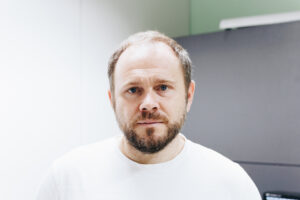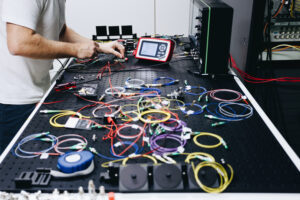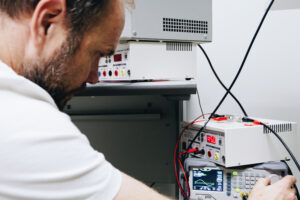CESGA projects Spain's longest quantum highway
Quantum key distribution promises to revolutionize communications security thanks to the invulnerability that the laws of quantum mechanics confer on the exchange of information. Applying this technology over long distances is a scientific and technological challenge to which CESGA, in collaboration with VQCC, contributes by deploying the longest quantum communication line in Spain. This sort of quantum highway between Santiago and Vigo will allow experimenting with sending encrypted information along 120 kilometers, with the expectation of creating branches to other points of Galicia in the future

The father of quantum. That is how the journal Nature labeled Jian-Wei Pan in 2017, when he was included in the list of the ten most outstanding researchers of the year. The relevance of his work transcends the barriers of science, to the extent that a year later, in 2018, Time magazine ranked him as one of the hundred most influential people in the world. His career is full of milestones, one of which was the launch of the world’s longest terrestrial quantum network in 2016, a line that connected the 2,000 kilometers between Beijing and Shanghai.
The competition to build long and efficient quantum communication lines underpins the race among the world’s major powers to lead this technology. Galicia is already in an honorable position in this contest: thanks to the initiative of the Galicia Supercomputing Center (CESGA), in collaboration with the Vigo Quantum Computing Center (VQCC), it will have the longest quantum communication line in Spain and one of the longest in Europe. This quantum highway approximately 120 kilometers long will link Santiago de Compostela and Vigo with the aim to perform experiments and use case demonstrations.
Quantum communication infrastructures are destined to revolutionize telecommunications, especially because they promise to guarantee seamless security in the exchange of information through systems that are invulnerable to external attacks. This is because these networks are governed by the laws of quantum mechanics, which ensure that qubits –the minimum units of quantum information– are impossible to copy without altering their state. Any alteration by an intruder raises an alert, causes the hacking attempt to be detected, and allows to abort the transmission.
The secret key
Current cryptography is based on the secret key. “The encrypted message can be transmitted through a public channel but the key must be sent through a secure channel. The vulnerability lies in the transmission of the key, which may be decrypted by an intruder without leaving a trace by a sufficiently elaborate method. Quantum key distribution solves this problem,” explains David Barral, from CESGA’s Communications Department, to explain the technology that supports the projected link between Santiago and Vigo.
Quantum key distribution (QKD) is considered the great hope for perfect security in communications. Sharing keys via QKD is normally done using laser-emitted photons (particles of light) as vehicles, since they are particularly effective at maintaining their quantum properties for relatively long time periods, allowing key sharing over longer distances.
 In the case of the Atlantic infrastructure, the challenge measures no less than 120 kilometers. “It is a significant distance because the light pulses are attenuated, that is, they lose photons when propagating through an optical fiber,” explains the CESGA researcher. “Fortunately, current laser sources allow us to send around one billion optical pulses per second. Despite the loss of photons that occurs along the way, by sending one photon in each pulse we could be able to detect several million photons per second.” That is to say, a bombardment of photons is provided at the source to ensure that a sufficient quantity reaches the destination. This is indeed the case because, according to Barral, “this makes it possible to generate keys of an adequate size in a reasonable time.”
In the case of the Atlantic infrastructure, the challenge measures no less than 120 kilometers. “It is a significant distance because the light pulses are attenuated, that is, they lose photons when propagating through an optical fiber,” explains the CESGA researcher. “Fortunately, current laser sources allow us to send around one billion optical pulses per second. Despite the loss of photons that occurs along the way, by sending one photon in each pulse we could be able to detect several million photons per second.” That is to say, a bombardment of photons is provided at the source to ensure that a sufficient quantity reaches the destination. This is indeed the case because, according to Barral, “this makes it possible to generate keys of an adequate size in a reasonable time.”
The highway along which these photons travel, the optical fiber, is the main technical challenge of the project. “The fiber must be single-mode, without the optical amplifiers that are usually found in fiber lines that enable to transmit classical information over long distances, since these destroy quantum information. In addition, the fiber will pass alongside gas pipelines, so we have to analyze the stability of the connection.”
Two use cases
Once Vigo and Santiago de Compostela are connected, the plan is to create secondary networks along the surroundings of both cities to extend their radius of action. “This line is the first step towards a Galician network of local networks in which information will be transmitted with the maximum security allowed by quantum physics. In addition, it will provide a test bank for other cryptographic and quantum communication protocols,” explains Barral.
In this respect, the CESGA researcher highlights the experimental nature of this infrastructure, designed to contribute to the advancement of technology from Galicia and for Galicia. “The line is both an infrastructure at the service of the research community and a showpiece for companies that wish to bet on quantum technologies. In fact, we have already projected two use cases involving several Spanish universities and R&D companies,” referring, in addition to the University of Vigo through the AtlanTTic research center, to the Polytechnic University of Madrid, the University of the Basque Country, and from the private sector, to the R&D center Tecnalia, and the company Ibermática.
The first use case seeks to apply quantum technologies to secure part of the communication channel between devices using 5G networks –such as mobile phones– using keys generated by QKD. “We will host a 5G core at CESGA that will be connected through the CESGA-VQCC line with a central unit and a distributed unit at the University of Vigo. There, another QKD line will be connected to a radio node, thus protecting the entire fiber optic part of a 5G network user’s communication by means of quantum key distribution,” specifies Barral.
The other use case focuses on the development of multi-hop QKD network management software through reliable nodes for the deployment of WAN networks (wide area networks, which define telecommunication networks that connect devices over long distances, as opposed to local networks or LANs). Currently, each pair –sender and receiver– of commercial QKD equipment has its own key manager that cannot dialogue with those of other companies. “Our aim is to develop a free software capable of managing the communication protected by QKD between any pair of network users, regardless of the brand or technology of the devices they use,” explains the CESGA researcher.
The other use case focuses on the development of a multi-hop QKD network management software through reliable nodes for the deployment of WAN networks (wide area networks, which define telecommunication networks that connect devices over long distances, as opposed to local networks or LANs). Currently, each pair –sender and receiver– of commercial QKD equipment has its own key manager that cannot dialogue with those of other companies. “Our aim is to develop a free software capable of managing the communication protected by QKD between any pair of network users, regardless of the brand or technology of the devices they use,” says the CESGA researcher.
The project led by CESGA’s team of researchers is developed within the framework of the Complementary Quantum Communication Plan (PCCC) and is aligned with the European Quantum Communication Infrastructure (EuroQCI) and the initiative for the development of quantum technologies in Europe (Quantum Flagship).
According to Barral, the expectations of the applicability of QKD technology over long distances point to a panorama of communication security that extends to multiple sectors and areas of everyday life. In the financial sector, he mentions data protection, e-commerce and communications between bank branches and headquarters. Governments and defense agencies will be able to protect communications with intelligence services and embassies, for example. The consultation of medical records and databases will be totally secure in health systems. In the field of energy, it can be used to control production plants and monitor infrastructures. Scientific research organizations and the pharmaceutical industry will be able to ensure the exchange of sensitive data regarding technological development. And, of course, in the fields of telecommunications and ICT, it will offer the necessary security guarantees for the transmission of information and access to servers or the cloud.
The quantum future
“In the medium term, these long-distance lines will be the backbone on which medium-sized QKD networks will be integrated into the communication infrastructure of cities,” estimates David Barral, who cites MadQCI, the QKD network of the metropolitan area of Madrid, as an example. “These projects represent a first step towards a future quantum Internet that connects quantum computers, simulators, and sensors at the national and transnational levels through secure quantum networks.”
According to the CESGA researcher, the success of this future forecasr depends on a flexible and iterative approach, where technological advances are integrated as they arise. “Our methodology requires us to be always up to date and to collaborate with other groups to keep us on the front line of development.”
This need to collaborate to go further is behind the complementary project that the center is developing with the University of Santiago de Compostela (USC) for the deployment of an experimental QKD link between its facilities and the Faculty of Optics, which will allow testing new quantum key distribution protocols and, in the future, create a secure network on a local scale.
Contact: dbarral@cesga.es
